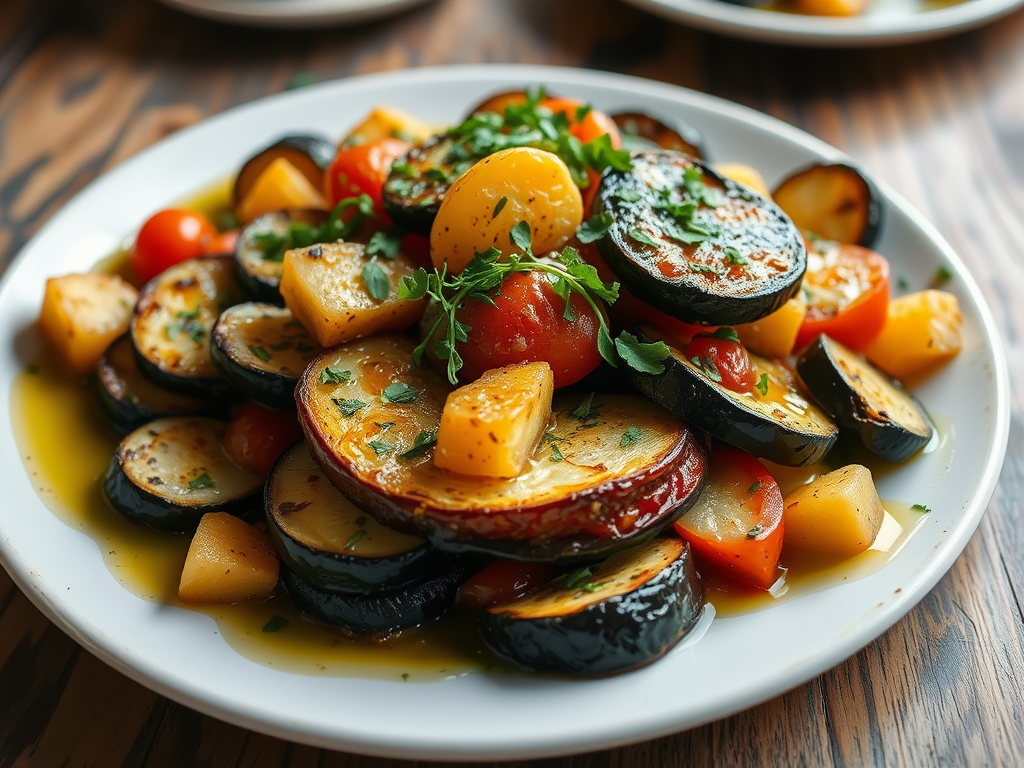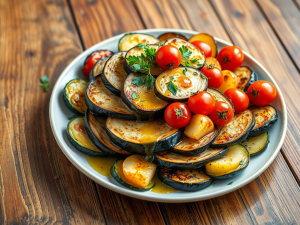
Briam, a traditional Greek dish, is a flavorful baked vegetable medley that embodies the essence of Mediterranean cooking. This dish is not only versatile and hearty but also a celebration of seasonal produce, making it a popular choice in Greek households and restaurants alike. Its simplicity and depth of flavor have made it a beloved staple in Greek cuisine for generations.
What is Briam?
Briam (or “briam” in Greek: μπριάμ) is a rustic dish made primarily from a variety of vegetables such as zucchini, eggplant, potatoes, and tomatoes, all seasoned with olive oil, herbs, and spices. The vegetables are often layered in a baking dish and baked until tender and caramelized. It is similar to the Italian ratatouille but has its unique flavors and preparation methods.
Historical Background
The origins of briam can be traced back to the rural kitchens of Greece, where home cooks would utilize whatever vegetables were in season to create satisfying meals. This practice reflects the Mediterranean way of cooking, which emphasizes fresh, local ingredients and simplicity. Over time, briam has evolved, with regional variations emerging across Greece. Each family may have its own special twist, often passed down through generations.
Ingredients
The beauty of briam lies in its adaptability. Common ingredients include:
- Zucchini: Adds a tender, slightly sweet flavor.
- Eggplant: Provides a rich, meaty texture and absorbs flavors beautifully.
- Potatoes: Contributes heartiness and substance, making the dish more filling.
- Tomatoes: Offers acidity and moisture, balancing the richness of the other vegetables.
- Onions and Garlic: Enhance the overall flavor profile with their aromatic qualities.
- Olive Oil: A staple in Greek cooking, it adds richness and depth.
- Herbs: Such as oregano, thyme, or dill, to infuse the dish with aromatic notes. Fresh herbs are preferred for their vibrant flavor, but dried herbs can also be used.

Optional Additions
While the traditional recipe focuses on the above ingredients, many variations exist. Some cooks add:
- Bell Peppers: For additional sweetness and crunch.
- Carrots: To enhance the dish’s natural sweetness.
- Cheese: Feta or goat cheese can be sprinkled on top before serving for added flavor.
- Chickpeas: For added protein, making the dish more substantial and nutritious.
Preparation
The preparation of briam is straightforward, making it accessible for cooks of all skill levels:
- Chop the Vegetables: Cut the vegetables into uniform pieces for even cooking. Aim for bite-sized chunks to ensure they cook through properly.
- Layering: In a large baking dish, layer the vegetables, starting with the denser ones like potatoes and eggplant, followed by zucchini and tomatoes. This layering technique allows the flavors to meld beautifully as they cook.
- Seasoning: Drizzle olive oil over the layers, sprinkle with salt, pepper, and herbs. Don’t be shy with the olive oil; it’s key to creating a deliciously rich dish.
- Bake: Cover the dish with aluminum foil and bake in a preheated oven, usually around 180°C (350°F), for about an hour. Remove the cover towards the end to allow for caramelization and a slightly crispy top.
Serving Suggestions
Briam is often served warm or at room temperature, making it an excellent dish for gatherings. It can be enjoyed as a main course, paired with crusty bread for soaking up the flavorful juices, or as a side dish alongside grilled meats or fish. A dollop of Greek yogurt or crumbled feta cheese on top can add a delightful creaminess, enhancing the overall experience.
Pairing Options
When serving briam, consider pairing it with:
- A Greek Salad: The freshness of a salad with tomatoes, cucumbers, olives, and feta complements the rich flavors of briam.
- Wine: A light, crisp white wine such as Assyrtiko or a medium-bodied red can enhance the meal.
- Pita Bread: Warm pita bread is perfect for scooping up the vegetables and juices.
Nutritional Benefits
Briam is not only delicious but also nutritious. It’s packed with vitamins, minerals, and antioxidants from the variety of vegetables. The use of olive oil provides healthy fats that are beneficial for heart health. This dish is naturally vegetarian and can easily be made vegan, making it suitable for many dietary preferences.
Health Benefits of Key Ingredients
- Zucchini: Low in calories and high in water content, helping with hydration.
- Eggplant: Rich in fiber, which aids in digestion and promotes a feeling of fullness.
- Tomatoes: High in vitamin C and lycopene, an antioxidant linked to many health benefits.
- Olive Oil: Contains monounsaturated fats, which can help reduce inflammation and lower cholesterol levels.
Conclusion
Briam is a testament to the simplicity and richness of Greek cuisine. Its ability to highlight seasonal vegetables and its straightforward preparation make it a beloved dish in many households. Whether served at a festive gathering or as a comforting family meal, briam is sure to impress with its vibrant flavors and wholesome goodness.
As you prepare your own briam, feel free to experiment with different vegetables and seasonings. This dish not only nourishes the body but also brings people together around the table, making it a true celebration of Greek culinary tradition. Try making briam, and experience a taste of Greece right in your kitchen.



